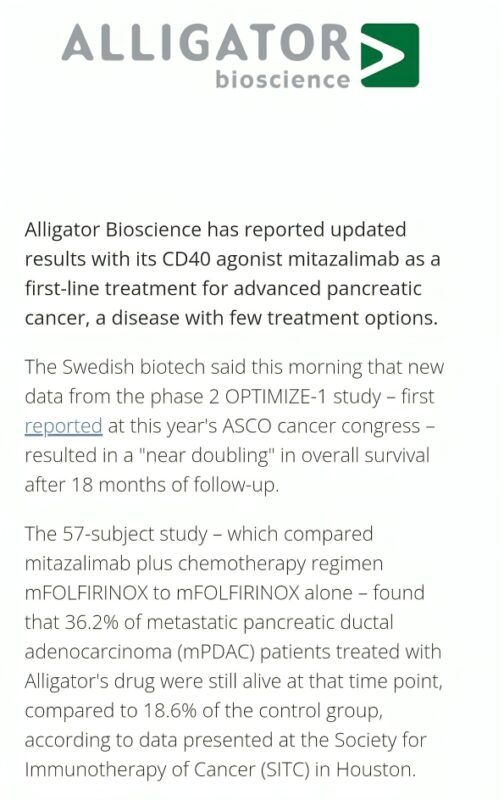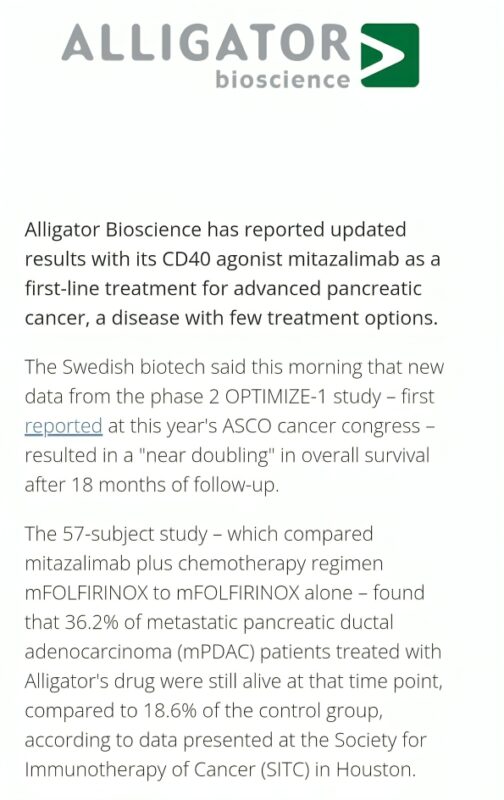
Rethinking Innovative Approaches to Pancreatic Cancer Treatment
The landscape of pancreatic cancer treatment has long been loaded with issues, but recent developments are rewriting the narrative. One such breakthrough is the combination of mitazalimab and a modified regimen of leucovorin, fluorouracil, irinotecan, and oxaliplatin—mFOLFIRINOX. As data from the OPTIMIZE-1 trial matures, the oncology community is beginning to see promising survival rates, marking what could be a transformative moment for patients with metastatic pancreatic ductal adenocarcinoma (PDAC).
As we take a closer look at these findings, it is important to share perspectives from clinicians, researchers, and patients alike. The final results of the OPTIMIZE-1 trial not only offer hope for improved survival but also open avenues for future confirmatory studies that may further shape our approach to a disease that has, for too long, remained intimidating and on edge for those diagnosed.
Breaking Down the OPTIMIZE-1 Outcomes in Metastatic Pancreatic Cancer
The OPTIMIZE-1 trial was an open-label, multicenter study that evaluated the effectiveness of combining mitazalimab with mFOLFIRINOX in patients with previously untreated metastatic PDAC. With a median follow-up of 33 months, the study reported a 30-month overall survival (OS) rate of 21%. While only a few patients remained on treatment at this stage, the data confirmed that the therapeutic benefits were durable and meaningful over time.
In addition to the long-term survival data, the trial provided key insights at earlier intervals: a 58% OS rate at 12 months, 37% at 18 months, and 26% at 24 months. These numbers stand in contrast to the often grim survival statistics associated with metastatic pancreatic cancer. It is these encouraging details – the fine points and subtle parts of the trial outcomes – that make the results noteworthy.
Advanced Pancreatic Cancer Treatment Outcomes: A Closer Look at Survival Metrics
Understanding survival data is critical in assessing the impact of innovative treatment combinations. The median overall survival reached 14.9 months, suggesting a considerable extension compared to historical benchmarks. The median progression-free survival (PFS) was reported at 7.8 months, further supporting the potential efficacy of the combination therapy.
It is essential for stakeholders to recognize that while these improvements may seem like incremental steps, they represent key progress in a therapeutic area where every additional month counts. The objective response rate (ORR) reached 54.4%, with a significant portion of patients demonstrating sustained responses for a median duration of 12.6 months. In a disease characterized by tricky parts and tangled issues, such numbers provide a beacon of hope.
Key Details and Figures from the Trial
| Metric | Value |
|---|---|
| 30-month OS rate | 21% |
| Median Overall Survival | 14.9 months |
| Median PFS | 7.8 months |
| Objective Response Rate (ORR) | 54.4% |
| Median Duration of Response | 12.6 months |
These key figures not only highlight the success of the treatment combination but also serve as a benchmark for future studies aiming to further unravel the tricky parts of PDAC management.
Unpacking the Role of Biomarkers and Immunomodulation
In parallel to the survival metrics, one of the most compelling aspects of the OPTIMIZE-1 study lies in its biomarker analysis. Researchers presented intriguing evidence that patients who responded to the combination therapy exhibited activation of intratumoral myeloid cells and T cells. Such findings suggest that immune stimulation plays a critical role in the observed clinical benefits.
This deeper look into the fine shades of immune response offers a window into the subtle dynamics at play. Notably, a novel fibrosis-related gene signature was identified that appears to correlate with improved OS, hinting at potential predictive capabilities. Understanding these little details might eventually allow clinicians to tailor therapy more effectively, steering through the tangled issues of patient selection in the future.
CD40 Agonist Therapy Biomarkers: Implications for Treatment Personalization
Mitazalimab serves as a CD40 agonist, a target that has long been considered promising in oncology due to its role in activating immune cells against tumors. The data from OPTIMIZE-1 have underscored that this approach may not only enhance the efficacy of chemotherapy but could potentially transform the treatment paradigm for aggressive cancers like PDAC.
Specifically, the activation of myeloid cells and T cells in patients with better outcomes confirms that the immune microenvironment is a key player in the response to therapy. This observation raises several important questions for future research:
- Could the identified fibrosis-related gene signature serve as a predictive tool for selecting patients who may benefit the most from this combination treatment?
- What are the precise mechanisms behind the activation of the immune components seen with mitazalimab?
- How might these findings translate to other cancer types with similarly challenging biology?
Answering these questions will require a deep dive into the molecular drivers of treatment response, but the preliminary data certainly set the stage for further exploration.
Clinical Challenges and the Tricky Parts of Metastatic Pancreatic Cancer Management
Metastatic pancreatic cancer remains one of the most intimidating and nerve-racking challenges in oncology. For decades, the treatment landscape has been full of problems, with limited therapeutic advances and an overall poor prognosis for many patients. Traditional chemotherapy regimens, while offering some benefit, have frequently hit roadblocks when it comes to achieving long-term survival.
In this context, the emerging role of immunomodulatory agents such as mitazalimab represents a critical turning point. The OPTIMIZE-1 trial, despite having its own set of complicated pieces and twists and turns, demonstrates that combining immunotherapy with chemotherapy might enhance treatment outcomes in ways previously unseen. It is a testament to the power of innovation that we are now able to challenge conventional wisdom and potentially shift the treatment paradigm in a disease that has long been off-putting.
Challenges in Patient Selection and Treatment Tolerability
The trial underscored the importance of careful patient selection. To participate, patients had to meet strict criteria, including an ECOG performance status of 0 or 1, measurable disease per RECIST v1.1 criteria, and no prior exposure to chemotherapy or abdominal therapy. Such stringent eligibility requirements ensure that only patients with a fair chance of benefitting from the treatment are enrolled, as the goal is to maximize safety and efficacy.
Even with a well-defined population, managing side effects and ensuring treatment tolerability remain significant hurdles. The study’s phase 1b portion focused on identifying the optimal dosing regimen for mitazalimab, which ultimately was determined to be 900 μg/kg. A smaller subset received 450 μg/kg, but the majority benefited from the higher dose when combined with the precise dosing of the mFOLFIRINOX components. This meticulous dose-finding process highlights the delicate balance required to achieve maximal therapeutic benefit while minimizing adverse events.
Understanding the Practical Implications for Everyday Clinical Practice
For the oncology community, breaking down these results into everyday practice involves navigating through several tricky parts and confusing bits of treatment logistics. Some of these include:
- Coordinating treatment schedules, as mitazalimab was administered on days 1 and 10 in a 21-day cycle and again 2 days after mFOLFIRINOX in subsequent 14-day cycles.
- Monitoring for dose-limiting toxicities—given that this was the primary endpoint during the phase 1b portion of the study.
- Ensuring uniformity in treatment administration across multiple centers, which is essential for accurate data interpretation.
For clinicians, these operational details might seem like minor points, yet they are super important because the success of any new regimen depends on its seamless integration into existing treatment frameworks. In essence, the trial has provided critical clues on how to figure a path through these practical challenges.
Key Considerations for Future Phase 3 Trials
Following the promising outcomes of the OPTIMIZE-1 trial, Alligator Bioscience plans to move forward with a confirmatory phase 3 trial in collaboration with a strategic partner. This next phase of research is expected to further validate the efficacy and safety of the mitazalimab/mFOLFIRINOX combination and potentially cement its role in the standard treatment protocol for metastatic PDAC.
The transition from early-phase trials to a larger confirmatory study is loaded with both opportunities and challenges. It is a reminder that while the early results are encouraging, the road to regulatory approval and widespread clinical adoption is full of tricky parts and complicated pieces once again.
Designing the Next Generation of Clinical Trials
Clinical trial design for future studies will need to address several key areas:
- Patient Population: Future trials might consider broader inclusion parameters, allowing for more diverse patient populations while ensuring safety criteria are met.
- Dosing Schedules: Refining the dosing schedule based on the learnings from OPTIMIZE-1 will be critical, particularly in balancing efficacy and tolerability during longer treatment durations.
- Biomarker Integration: Incorporating advanced biomarker analysis into trial protocols can help tailor treatment to individual patient profiles, potentially leading to more effective personalized therapy.
- Real-World Data: Leveraging real-world evidence can help bridge the gap between clinical trials and everyday clinical practice, enabling a smoother translation of research findings into routine care.
Each of these points represents not just a technical detail but a critical component of a successful trial strategy. The experience from OPTIMIZE-1 provides a clear roadmap that underlines the importance of effective trial design in tackling the many twists and turns inherent in treatment innovation.
Stakeholder Perspectives on the Next Phase
Collaboration between pharmaceutical companies, clinical investigators, regulatory bodies, and patient advocacy groups will be key in orchestrating the next phase of research. Stakeholders have emphasized that while these early results are encouraging, the confirmatory phase must be meticulously planned and executed to address the small distinctions and nitty-gritty of treatment response.
Moreover, the oncology community is calling for transparency and robust data sharing to accelerate progress. It is only by working together that we can stitch together the fine points of successful clinical innovation and deliver new, much-needed treatment options to those confronting metastatic pancreatic cancer.
Implications for the Future of Pancreatic Cancer Care
The results from the OPTIMIZE-1 trial are more than just numbers or percentages—they represent hope. For patients and families facing the scary and overwhelming diagnosis of metastatic pancreatic cancer, every incremental improvement in survival and quality of life is a breakthrough. As we figure a path forward, these findings remind us that even in illnesses renowned for their problematic history, transformative therapies can emerge when science and innovation come together.
What makes this development so compelling is not only the clinical effectiveness but also the promise of a treatment that activates the body’s own immune defenses. In a disease where traditional chemotherapy has often felt like a race against time, boosting the immune system offers a fresh perspective that could redefine future treatment strategies.
Alternative Perspectives and Ongoing Dialogues in Oncology
Critics and proponents alike recognize that while these findings are promising, they also expose some of the tangled issues in cancer treatment research. Concerns remain regarding long-term side effects, quality of life during extended treatment courses, and the financial implications of advanced therapies. These are not insignificant considerations, but they are part of the evolving conversation as we work through the many confusing bits and hidden challenges of drug development and approval.
As the community begins to absorb these new insights, several key themes emerge:
- Patient Empowerment: Increasing patient involvement in treatment decisions is becoming a super important focus. Empowered patients who understand the fine points of their therapy are better equipped to manage their care and expectations.
- Multidisciplinary Approaches: Integrating oncologists, immunologists, geneticists, and nutrition experts into a cohesive care team is critical to manage the diverse and tricky parts of pancreatic cancer treatment.
- Data-Driven Decisions: Leveraging robust clinical data to inform treatment strategies is essential. With the aid of advanced analytics, clinicians can more effectively identify the subtle details that predict a patient’s response to therapy.
Such themes point to a future where treatment regimens are not one-size-fits-all, but carefully tailored to each patient’s unique clinical narrative. It is a future that will rely heavily on collaboration, innovation, and a willingness to experiment with new ideas despite the intimidating challenges along the way.
Expert Opinions and the Path Ahead
Leaders within the oncology field have hailed the OPTIMIZE-1 trial as a beacon for what is possible when immunotherapy and chemotherapy are combined in a strategic manner. Many experts believe that mitazalimab has the potential to become a key element in a multifaceted approach to pancreatic cancer care.
One notable voice in the discussion remarked, “The final findings from OPTIMIZE-1 reinforce a belief that we are truly entering a new era in pancreatic cancer treatment. With further research, we could see a transition from standard monotherapies to regimens that blend immunologic stimulation with the proven effects of chemotherapy.”
This sentiment is echoed by many professionals who see potential not just for improved survival statistics, but also for enhanced quality of life and a more nuanced understanding of how the immune system can be harnessed to fight aggressive malignancies.
Integrating New Therapies into Standard Practice
For the time being, the next steps are clear: continued research, cautious optimism, and an unwavering commitment to improving patient outcomes. As the industry moves toward a potential phase 3 trial, several considerations will be especially crucial:
- Regulatory Alignment: Ensuring that new trial protocols meet stringent regulatory standards will be a critical part of advancing the combination therapy into broader use.
- Economic Impact: Addressing the cost issues and insurance coverage for advanced therapies remains a key practical challenge that needs to be sorted out early in the development process.
- Real-World Applicability: Bridging the gap between controlled clinical environments and everyday clinical settings is essential to demonstrate that the benefits seen in trials are reproducible in general practice.
By remaining engaged in open dialogue and continuous learning, the research community can work through these issues and ensure that the best treatments make a smooth transition from the trial phase to real world application. In doing so, we can get around many of the current obstacles and transform a field that has been as nerve-racking as it has been challenging.
Conclusion: Shaping the Future of Pancreatic Cancer Innovation
In summary, the recent data from the OPTIMIZE-1 trial marks a promising advance in the fight against metastatic pancreatic cancer. The combination of mitazalimab and mFOLFIRINOX is offering new hope by delivering encouraging survival outcomes, activating crucial immune cells, and providing insights into predictive biomarkers that could pave the way for a personalized approach to therapy.
Every percentage point increase in overall survival and every extension in progression-free survival is a step forward in a realm that has been both tense and intimidating for patients and families alike. This breakthrough demands further investigation and a robust commitment to addressing the subtle details and practical challenges that lie ahead. It is clear that in order to figure a path through the tricky parts of pancreatic cancer treatment, a multidisciplinary strategy that embraces innovative immunotherapeutic approaches is not just beneficial—it is super important.
While there is still a long road ahead before these therapies can become a standard first-line treatment, the present findings offer a solid foundation upon which the next generation of studies can be built. As more data emerge, the collective hope is that these therapies will not only extend life but also improve its quality, allowing patients to navigate the twists and turns of their journey with newfound resilience.
As we look to the future, the evolution of cancer treatment continues to be driven by trial and error, research collaborations, and most importantly, the persistent quest for better solutions. The OPTIMIZE-1 trial stands as a testament to what can be achieved with visionary science, careful planning, and an unwavering commitment to overcoming even the most nerve-racking challenges. By tapping into the power of immunomodulation alongside traditional chemotherapy, we may very well be on the cusp of a new era in pancreatic cancer care—one that is defined by hope, innovation, and the relentless pursuit of improved patient outcomes.
Moving Forward: A Call for Continued Innovation
The journey from promising trial results to everyday clinical success is layered with many complicated pieces and confusing bits. Yet, what remains clear is that the oncology field is shifting toward treatments that offer not only survival benefits but also promise a better quality of life. Stakeholders at every level—from researchers and clinicians to patients and policymakers—must work together to take these encouraging data points and transform them into real-world benefits.
As we continue to fine-tune treatment protocols, embrace new biomarkers, and explore innovative dosing strategies, the ultimate goal remains the same: to turn an intimidating diagnosis into a manageable condition, and eventually, into a conquerable challenge. In achieving this goal, every new study, every patient story, and every carefully calibrated dosage brings us one step closer to a reality where pancreatic cancer is no longer a near-certain death sentence but rather a disease that can be effectively fought and managed.
In closing, the OPTIMIZE-1 trial has provided a foundation that is both robust and rich with possibilities. The next few years are likely to see further refinements and, hopefully, groundbreaking advances that will cement the role of immunotherapy in the treatment of one of the most formidable cancers faced by modern medicine. As the journey continues, each stakeholder is invited to stay informed, advocate for continued research, and contribute to a future where hope and innovation drive every decision in the care of patients facing metastatic pancreatic cancer.
Originally Post From https://www.cancernetwork.com/view/mitazalimab-chemo-yields-promising-survival-responses-in-untreated-pdac
Read more about this topic at
Advances in Pancreatic Cancer Research – NCI
Progress in Pancreatic Cancer: A 2025 Update from Dr. …


